[Author's note: I have heavily annotated this post, hopefully with "interesting" footnotes. For ease of reference, and to read the footnotes as they appear, consider opening a second tab for this post and scrolling to the end.]
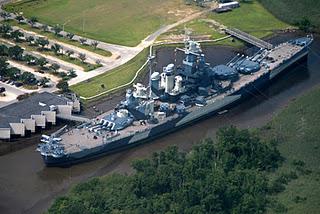
USS North Carolina
My dad and I, ever the enthusiasts of the historically interesting, were driving from Baltimore to Wilmington, North Carolina, on a quick sojourn to see the USS North Carolina[1], a World War II era battleship. It was early March, and our destination was more than a little motivated by my desire to take a short trip somewhere south (we were only just emerging from an unusually cold Maryland winter). Visiting the ship would allow us to interact with an actual historical artifact, not a battlefield or a monument, but a real object, something that had been "there," something we could see, and touch, and walk through.In late afternoon, and after nine hours on the road, we arrived in Wilmington, which is located in the far southeast[2] of the state, along the Cape Fear River and just a few miles from the Atlantic Ocean. The city's population has nearly doubled in the last two decades, but even by a generous assessment it remains mid-size. On first view it makes little impression, there's no distinctive skyline -- in fact no skyline -- on the approach to town. There's little sense that you've actually arrived anywhere, just the flat coastal greenery broken up by the standard low-rise, low-density development characteristic of American suburbia. However, we found our way by twists and turns to the center of the city, which included a quaint downtown with an abundance of antebellum architecture situated on the east bank of the river. And from that vantage point we spied the impressive silhouette of the North Carolina, cozily berthed in a narrow cove on the river's west bank. It was getting late, the ship was dark against the fading sun, but at least we knew where we were going the next day.
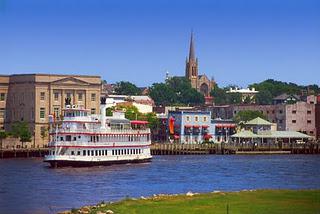
Central Wilmington
Wilmington is an interesting location for the ship, now a National Historic Landmark. As North Carolina's only real seaport, it makes sense for the ship to be docked there, but Wilmington is a provincial city, out of the way -- you have to want to go to Wilmington to end up there. In a way that's a fitting place for the North Carolina, a fair analog to the role it played in history.---
USS North Carolina
The next day, Saturday, was exquisite. The sun was what meteorologists like to term, brilliant; the sky a clear cerulean. The air held the first hints of vernal warmth. In late morning, we crossed the river just downstream of the ship, but we didn't get a good view until we pulled into the parking lot. We were among the first there. Looking from up close, it's hard not to be impressed with the North Carolina. Our first perspective was of the ship's profile. The hull sweeps in a majestic arc, parallel to the water at the stern and rising to its exaggerated wave-splitting bow. The busy but balanced superstructure rises from the center of the hull and is guarded closely by three massive gun turrets, two fore and one aft of the superstructure. The ship is painted with a fresh dazzle scheme of alternating gunmetal gray and bluish white, which was meant as a form of camouflage...though I doubt the North Carolina could be missed. The ship is more than two football fields long and its radar tower rises to 200 feet above the waterline. Large enough that you have to turn your head to see it all even from a hundred paces away.
One must pass through a visitor's center[3] (and gift shop) to board the ship. There's a gangway from the visitor's center to the stern-half port-side deck (the ship faces west). The cove where the North Carolina is moored looks like it was made to fit the ship (and it probably was dredged for this purpose). Indeed, the water is so still and likely has received so much sedimentation since the North Carolina was towed into position fifty years ago, that the massive hull probably rests on the bottom. My dad labeled it, "a mud hole,"[4] and it does seem incongruously narrow and shallow and confining for the mass of the ship. The deck surface isn't steel, but teak[5], a wood durable enough to stand up to the corrosive effects of seawater and that doesn't get slippery when wet. It's a pleasant sandy brown color, which complements the gray and white of the rest of the ship. Once on board, everything looks even bigger than from the shore. It looks like what it was designed to be, an engine of war.
A Very Brief Review of Battleship Design
The tour of the North Carolina is self-guided. Large sections of the superstructure and some sections below decks are open for inspection. You can also go into one of the huge gun turrets, which is accessed from the deck not far from where we stood, so that's the first thing we checked-out.
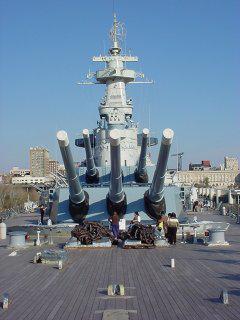
The massive guns
You have to climb into the turret from the back via a steep metal staircase and a small opening in the underside of the turret head. It's awkward and the unforgiving hard steel and sharp edges seem designed to cause painful head bangs. Needless to say, we entered the dark turret gingerly. Inside it was cramped. The station is meant for a few sailors and there are separate sections for gun sighting and firing on the one hand (in the rear and above), and muzzle loading on the other (below and in front). The guns are what other ships would target first, so the exposed turret struck me as a vulnerable place to be, even if the face of the turret is protected by 16 inches of steel (though only seven inches on the roof). This exposed portion of the turret is just the visible part of a much larger system (of which there is more described below), but it leads to a quick discussion of battleship design.The development and design of the North Carolina-class[6] battleship is too long and too involved to summarize here. But understand that from the time the first modern battleship, Jackie Fisher's Dreadnought, was launched in 1906, through World War II, battleships were designed as a balance of three competing parameters: guns, armor, and speed. Bigger guns allow a ship to fire larger shells longer distances and sink otherships before the other ship’s smaller guns can fire back. Thicker armorprotects a ship against ever bigger shells (not to mention bombs and torpedoes). And speed allows a ship to outrun, or rundown, slower ships. As arule you can have an abundance of two of these characteristics but not allthree: for speed and guns, you have to give up weight, in the form of sacrificedarmor. For protection and firepower, you’ll be heavy and have to give up speed.Historically, battleships were built to give up speed or armor. The latterchoice proving disastrous[7]
Against these general designfeatures, the North Carolina-class, the first class[8] of battleships built by the U.S.navy since just after World War I, was required to adhere to the sizelimitations established by the London Naval Treaty (which followed theWashington Naval Treaty). Plus the ships needed to be built to fit through thePanama Canal for easy deployment to either the Atlantic or Pacific. Add to thatthe desire for a relatively shallow draft so the ships could enter as many U.S.ports as possible. Of course the Japanese and German navies had little interestin following the letter of the London Treaty, so in response, the NorthCarolina class was modified (in mid-build) to be more formidable versus treaty-breakingGerman/Japanese ships, including bigger guns, which brings us back to the turret.
The North Carolina is equipped withnine, 16-inch guns distributed evenly over her three turrets. Each barrel is 60feet long. Hold your hands 16 inches apart. That’s how wide the cylindricaldiameter of a 16-inch shell is. Each shell is over four feet long and weighs inexcess of 2,000 pounds. Each of NorthCarolina’s main guns could fire an armor-piercing shell a distance of about23 miles. The muzzle velocity of these shells was over 1,500 mph (2,300+ ft/s),twice the speed of sound. The broadside of a modern battleship was a fearsomesight (and deafening sound).
A Short History
After exiting the turret, we toured the open sections of superstructure, which included themain bridge and battle bridge, captain’s quarters, officer’s lounge, somehigher lookout perches (though not all the way to the top). Unfortunately, mostof the instrumentation was removed from these areas. From above you can lookdown on the sprawling acre-sized deck, including the various smaller caliberguns generously deployed over the deck and superstructure, which were used forclose range anti-ship targeting and anti-aircraft fire. You start to get abetter sense of just how intricate these vessels really are.
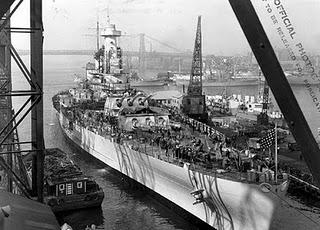
North Carolina under construction in New York
The North Carolina’s keel waslaid down in late 1937 in the New York Naval Shipyard and was finally launchedin June 1940. She was commissioned in April 1941 and completed her at-seashakedown before the Japanese attack on Pearl Harbor. She was sent to thePacific just after the Battle of Midway in June 1942 and saw action in almostevery major campaign: Guadalcanal, the Gilbert Islands, Marshall Islands,Marianas, the Philippines, Iwo Jima, and Okinawa. The ship was probably asactive as any other battleship from any navy in the entire war[9].For its service during the war, the ship was awarded 12 Battle Starsand eight medals – the ship. Am I theonly one who finds that strange? Last I checked the ship was inanimate, made upof thousands of tons of steel and various mechanical and electrical systems. Itwas the men on board who took the ship into battle, and were the reasons forwhatever successes (and loses) followed. But of course, the larger point isthat ships like the North Carolinatake on significance beyond a mere machine. The North Carolina is a symbol forall the men who served on her. Further,battleships, even in huge navies like that of the U.S. during World War II, weresmall in number. And they had a massive effect on the overall strategicsituation (or were perceived to – see below). The U.S. built tens of thousandsof tanks and trucks, and even more planes during the war. No individual unitwas special (or even mattered). But when all eight Pacific Fleet battleshipswere damaged or sunk during the attack on Pearl Harbor, the strategic situationin the Pacific was substantially altered (for a little while), and a nation wasshocked and roused to war.
After the war the North Carolina helped transport American servicemen back from thePacific, was decommissioned (in 1947), and mothballed in the reserve fleet. Shewas struck from the naval register in 1960 and bought by the people of NorthCarolina in 1961, when she saw the open sea for the last time before beingtugged up the Cape Fear River and maneuvered into her current berth.
Some Design Detail
I've provided some sense of the size and equipment, but here's a more detailed list to give you a more formal sense of the presence, the heft, of the North Carolina:
- Length: 729 feet;
- Beam (width): 108 feet;
- Draft: 33 feet, which seems remarkably shallow considering it's basically a floating chunck of steel;
- Displacement (weight of water it displaces): 45,000 tons fully loaded, or about the size of a large modern cruise ship;
- Engine Power: 121,000 horsepower;
- Speed: 26 knots, or about 30 mph
- Range before refueling: 20,000 miles at 15 knots or 6,600 miles at 25 knots;
- Crew: over 2,300, 140+ officers and 2,200 enlisted;
- Armor: 16 inches of steel at the waterline and turret faces, 7 inches on the main deck;
- Armament: 9-16-inch guns, 20-5-inch guns, lots of 1.1-inch guns and 0.50 caliber machine guns.
All those numbers translate to large and powerful, and costly. The price of the North Carolina was over $76 million, which is more than $1 billion in today's terms. It costs a lot to put a floating fortress to sea.
As an example ofthe bulk of a battleship: You can only view a small portion of the turrets, whichextend right down to the bottom of the hull. They are so massive that they aren’tactually attached to the rest of the ship, gravity keeps them in place[10]. At the bottom isthe magazine room where all of the shells and cordite were stored (separatelyfor obvious safety reasons). During battle or firing exercises, the shells and corditewere transported to elevators and lifted up several decks to be breech-loadedinto the guns. The rotating upper portion of turret basically sits on hugeball-bearings just below the deck. Each turret required 150 men to operate.
Below Decks, the Battleship Inferno
One thing strikes you as you step inside the ship and head below the deck: You’dmuch prefer to have been assigned to above-deck duties. The dark, narrowcorridors, steep step ladders, low ceilings, and endless small compartmentsyield an acute sense of claustrophobia. Like the turret entrances, thecountless constricted doorways seem to have been designed to trip and concussany careless seaman. Of course for flood control, the hulls of large ships aredivided by bulkheads into numerous sections that are then subdivided intomyriad smaller compartments. I won’t begin to guess how naval architectsdreamed up the interior layout, but a battleship with 2,300 crewmen needed lotsof compartments for the myriad functions those men had to carry out, the placesthey worked, slept, ate, showered, went to the bathroom, and soughtentertainment (what little there was). The inside is truly labyrinthine[11], and Iimagine how easy it would be to get lost in the bowels of the ship[12].
In the case of massive flooding or fire, escape required you to windyour way, along with dozens or hundreds of other men, up stairs, aroundcorners, through corridors to the deck, likely in the dark. If the ship was sinkingfast, or was engulfed in flames and blinding, suffocating smoke, you stoodlittle chance. That’s why so many battleships sunk in battle had such appallinglyhigh casualty rates[13].
However, these concerns, real and frightening, were acute and relatedto battle. Most of the time, the ship would be steaming in less danger. Herethe un-pleasantries of everyday life would have to be faced. Walking throughthe corridors, the mess hall, the lavatories you think of what must have beenthe heavy, clinging, inescapable odor of men. The tropical South Pacific sunwould have baked the steel ship, and the heat below decks must have beenintense. This wasn’t the age of air-conditioning, and a few fans were all thatwas available for ventilation – surely insufficient to refresh the stagnant air.The men’s sweating would have only added to the intensity of the humid odoriferousenvironment; maybe not as bad as, say, a German U-Boat[14], but pretty badnone-the-less. And that’s in calm seas. The mind recoils in horror at whatbelow deck was like during a storm, with undoubtedly rampant seasickness addingto the pungency of the air; vomit flowing across the floor slightly out of syncwith the heaving of the ship. A sickening image certainly, but certainly trueof life at sea.
Now walking through the corridors, the shipempty and the outside air temperate, there is little noticeable smell. Theinterior is as sharp and fresh looking as the outside. History made clean
An Unexpected Role
On September 15, 1942 during an action near Guadalcanal, a torpedofired from a Japanese submarine struck the North Carolina on her port side, 20feet below the waterline. The powerful blast opened a 30-foot by 20-foot holein the hull. Five men were killed and the ship took on a substantial amount ofwater, causing it to list slightly. However, skillful and speedy damagecontrol, and the overall size of the ship prevented the possibility offoundering. After the battle, the NorthCarolina received temporary repairs in the South Pacific before sailingback to Pearl Harbor for extensive repairs and refitting.
The incident reveals an important irony about the role of battleships.As conceived, battleships were the most powerful warships, designed to controlthe sea lanes and project naval power. They certainly looked the part withtheir imposing size and huge guns. They were designed to sink other ships, mostespecially other battleships. This was true right up until World War II. Whatnaval planners failed to realize was that battleships were not the mostpowerful, or important, warships. The advent of aviation, followed by navalaviation and aircraft carriers, changed everything. Planes could attack atlonger distances than even the most powerful ship guns. From as early as the1920s it was realized that planes could damage and even sink large, heavilyarmored vessels, but naval dogma held that large battleships were the wayto naval dominance. Events in World War II ended this myth. The British attackon the Italian fleet at Taranto in 1940, the sinking of the Bismarck[15], the Japanese attack on PearlHarbor, and subsequent sinking of the British battleships Repulse and Prince of Walesoff Malaya in 1941, showed that battleships were desperately vulnerable toaerial attack. Add to that the threat from submarines, which battleships werenot equipped to fight (that’s what destroyers were for), and what was supposedto be a vessel of supreme power became an assailable target of smaller, and farcheaper, weapons from above and below.
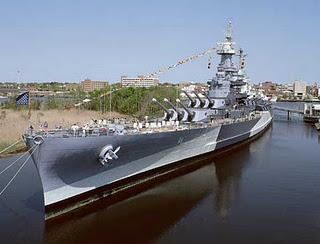
A graceful, powerful...support ship
The Battle of the Coral Sea in May 1942 between Allied and Japaneseforces was entirely fought by planes from each side’s aircraft carriers. Thecombatant ships never saw one another, the first such occurrence in history.The era of the battleship had ended and the era of the aircraft carrier – anera we still live in – was realized. For the rest of the war, battleshipsbasically played a support role. They protected aircraft carriers from othersurface ships and aircraft, and supported naval invasions with bombardmentsfrom their heavy guns. Except in rare instances, they never used their heavyguns against other battleships. In a sense, NorthCarolina was obsolete, or at least its value was greatly diminished, beforeit was even commissioned.In the whole history of the battleship, the number of engagementsbetween heavy ships was surprisingly scant. The ships were too valuable[16] and theirintended role too quickly usurped to fulfill the function they were designedfor. For all of the allure they possessed (and still possess) and the attentionthey received, battleships never proved to be the strategic assets theirinvestment suggested.
A Monument
Finding our way back to the deck, we emerged from the dim interior intoblinding sunlight; the decks were now crawling with people. The crowd drawn byan interesting destination on a lovely spring Saturday. With a littleimagination you could transform the people into members of the teeming crew; scurryingacross the decks carrying out their daily routines. The day just warm enough tosuggest the equatorial sun. The mild lapping against the hull a hint ofsteaming in the open sea. But of course, we weren’t in the South Pacific andthis wasn’t World War II. This was a quiet corner of North Carolina and thebattleship was just a memorial, a denuded version of its wartime self.
To our left, the doors to the spacious officer's lounge we flung open, a large group a revelers were gathered inside. Apparently there was a birthday party going on. The ship a novel location for the celebration. History for sale.
And that reveals the central truth about the North Carolina. The battleship was born in New York as a symbol of American military power and has ended up in North Carolina as a "point of interest." Despite its seeming omnipresence in the many battles of the war against Japan, its role was rarely crucial, mostly secondary. And today it rests as something to see on a fine weekend afternoon. It’s appreciated if not celebrated. And like the battleship in World War II, it has taken on a role that few likely envisioned. But at least it performs the role well.
---
NOTES:
[1] American battleships were named after states, think of the USS Arizona and the USS Missouri. In the modern navy, ballistic missile submarines and someattack submarines are named after states – the Virginia-class submarine USS North Carolina was commissioned inspring 2008. The battleship is the fourth navy vessel to be named the North Carolina.
[2] Wilmington is probably the northernmost eastern U.S. city that actuallysatisfies my climate criteria of “subtropical.” Even in January the average lowtemperature is above freezing and palmetto trees grow in and around the city.
[3] Large, new, interesting, and professional.
[4] There was a sign indicating that an alligator – nicknamed “Willie,” orsomething like that – lived in the water and adjacent riverbank surrounding theship. And alligators hardly like deep, open water. My dad became strangely obsessedwith spotting the animal for the remainder of the time we were on deck. Hedidn’t, much to his disappointment.
[5] The present teak deck is not the original, and was part gift/partpurchase from Myanmar.
[6] Consisting of the North Carolinaand her sister the Washington, whichwas scrapped in 1961.
[7] In the years leading up to World War I, naval architects becameenamored with a new ship, the battlecruiser. This type was armed with guns asheavy as battleships but with thinner armor and faster speed. The theory wasbattlecruisers could outgun smaller fast vessels (like cruisers) and outrunlarge heavily armored battleships. In practice, battlecruisers were treatedlike battleships, including fighting in the “line-of-battle” with battleships.The result, as demonstrated at the Battle of Jutland and other engagements, waslightly armored battlecruisers trading fire with heavily armored battleships.The speed advantage of the lighter ships was not utilized and ultimately theweaker armor proved their downfall. AtJutland, four heavy ships were sunk, all battlecruisers, three British and oneGerman. Refer to Robert K. Massie's excellent Dreadnought for a fuller discussion. Another famous battlecruiser to be sunk by a battleship occurred earlyin World War II when the H.M.S. Hoodwas literally annihilated by the fearsome German battleship Bismarck. See the movie Sink the Bismarck for a visualization ofthe event.
[8] And what turned out to be the antepenultimate class. There followed theSouth Dakota-class, which consisted of the SouthDakota, Indiana, Massachusetts, and Alabama, all of which were commissioned by the summer of 1942.Finally there was the famous Iowa-class, which consisted of the Iowa, Missouri, Wisconsin, and New Jersey. These ships served on andoff as part of the active navy through the Gulf War, though they were highlymodified during their long service life. The Missouri is famous for receiving the formal surrender of Japan in Tokyo Bay and was featured in the action movie Under Siege. Currently, it’s berthed along Battleship Row in PearlHarbor. The Wisconsin is on displayin Norfolk, Virginia, and the New Jerseyin Camden, New Jersey. This writer has visited both of the latter. The Iowa is undergoing repairs andwill be permanently located at the Pacific Battleship Center in Los Angeles.
[9] Too often battleship from other navies stayed in port, see the GermanTirpitz and Japanese Yamato.
[10] When the Bismarck sank itturned over and the four turrets, unattached to the hull, dislodged and sankseparately to the ocean floor.
[11] Unfortunately, the great bulk the lower decks was closed off, including the engine areas (the engines might not even be there anymore), forecastle, working compartments, etc., which diminishes my firsthand account.
[12] I’m pretty sure the ship didn’t have any of those helpful “YOU AREHERE” diagrams that you find posted everywhere on modern cruise ships.
[13] For instance, the sinking Hood, referenced in footnote 7, explodedviolently and sank in a matter of a few minutes. Most crewmen were not killedby the explosion but didn’t have time to abandon ship. Of the more than 1,400men on board, only three – three! –survived.
[14] See the movie Das Boot for somesense of what life on cramped German U-Boat was like. Talk about a horribleassignment!
[15] The Bismarck was felled byslow, outdated bi-wing carrier-launched bombers. One plane dropped a torpedothat struck the Bismarck’s rudderrendering the ship un-maneuverable. As a result, the British were able to closein and overwhelm the vessel with vastly superior firepower.
[16] For instance, during World War I, when Allied blockades were causingharsh shortages in Germany, the Imperial Fleet was kept largely in port (exceptfor a short period culminating at Jutland). The ships were too valuable to risklosing in battle. They were symbols and not weapons. Perhaps a modernequivalent is nuclear weapons.

